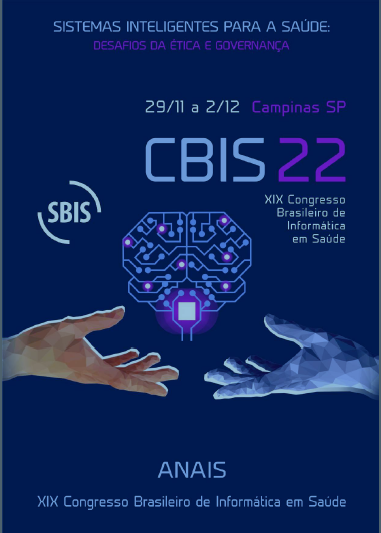Comparison of QRS Complexes’ Classifiers Developed Using Machine Learning
DOI:
https://doi.org/10.59681/2175-4411.v15.iEspecial.2023.1074Keywords:
Machine Learning, Heart arrhythmia, ElectrocardiogramAbstract
Cardiovascular diseases are the most common cause of death and its early diagnosis is key to prevention(1). In 2019, there were 17,9 million deaths caused by cardiovascular diseases globally(1). In the case of arrhythmias, they can be detected through an electrocardiography(2). Some papers have proposed and built models to heartbeat classification(3-7). In this work, three machine learning models were built, based in the MLII lead of the MIT-BIH Database, using a decision tree, multilayer perceptron and deep neural network using two different balanced versions of the same data to classify between 10 arrhythmias. The models were trained with 5-fold stratified cross-validation and their performances, compared using de F1-Score metric, were statistically analyzed with the deep neural network having a better performance within both databases.
Downloads
References
World Health Organization. Cardiovascular diseases [Internet]. Who.int. World Health Organization: WHO; 2022. Available from: https://www.who.int/health-topics/cardiovascular-diseases#tab=tab_1
Pastore C, Pinho J, Pinho C, Samesima N, Pereira-Filho H, Kruse J, et al. III Diretrizes da Sociedade Brasileira de Cardiologia sobre análise e emissão de laudos eletrocardiográficos. Arquivos Brasileiros de Cardiologia. 2016;106(4).
Alfaras M, Soriano MC, Ortín S. A Fast Machine Learning Model for ECG-Based Heartbeat Classification and Arrhythmia Detection. Frontiers in Physics. 2019 Jul 18;7.
Llamedo M, Martínez JP. Heartbeat Classification Using Feature Selection Driven by Database Generalization Criteria. IEEE Transactions on Biomedical Engineering. 2011 Mar;58(3):616–25.
Shaker AM, Tantawi M, Shedeed HA, Tolba MF. Generalization of Convolutional Neural Networks for ECG Classification Using Generative Adversarial Networks. IEEE Access. 2020;8:35592–605.
Hübner LG. Classificação de ritmos cardíacos em tempo real aplicando tecnologias embarcadas [Internet] [Dissertation]. [Universidade Estadual do Oeste do Paraná]; 2020. p. 1–148. Available from: https://tede.unioeste.br/handle/tede/5114
Zhang Z, Dong J, Luo X, Choi K-S, Wu X. Heartbeat classification using disease-specific feature selection. Computers in Biology and Medicine. 2014 Mar;46:79–89.
Hall JE. Guyton and Hall Textbook of Medical Physiology : Enhanced E-book. London: Elsevier Health Sciences; 2012.
MIT-BIH Arrhythmia Database v1.0.0 [Internet]. physionet.org. Available from: https://physionet.org/content/mitdb/1.0.0/
Can Ye, Coimbra MT, Vijaya Kumar BVK. Arrhythmia detection and classification using morphological and dynamic features of ECG signals. 2010 Annual International Conference of the IEEE Engineering in Medicine and Biology. 2010 Aug;
User guide: contents — scikit-learn 0.22.1 documentation [Internet]. Scikit-learn.org. 2019. Available from: https://scikit-learn.org/stable/user_guide.html
Home - Keras Documentation [Internet]. Keras.io. 2019. Available from: https://keras.io
TensorFlow. TensorFlow [Internet]. TensorFlow. 2019. Available from: https://www.tensorflow.org
Aurélien Géron. Hands-on machine learning with Scikit-Learn and TensorFlow concepts, tools, and techniques to build intelligent systems. O’Reilly Media, Inc.; 2019.
Gifari MW, Zakaria H, Mengko R. Design of ECG Homecare:12-lead ECG acquisition using single channel ECG device developed on AD8232 analog front end. 2015 International Conference on Electrical Engineering and Informatics (ICEEI). 2015 Aug;
Downloads
Published
How to Cite
Issue
Section
License
Copyright (c) 2023 Guilherme Bachega Gomes, Rômulo César Silva, Adriana Tokuhashi Kauati, Lucas Guilherme Hübner

This work is licensed under a Creative Commons Attribution-NonCommercial-ShareAlike 4.0 International License.
Submission of a paper to Journal of Health Informatics is understood to imply that it is not being considered for publication elsewhere and that the author(s) permission to publish his/her (their) article(s) in this Journal implies the exclusive authorization of the publishers to deal with all issues concerning the copyright therein. Upon the submission of an article, authors will be asked to sign a Copyright Notice. Acceptance of the agreement will ensure the widest possible dissemination of information. An e-mail will be sent to the corresponding author confirming receipt of the manuscript and acceptance of the agreement.





